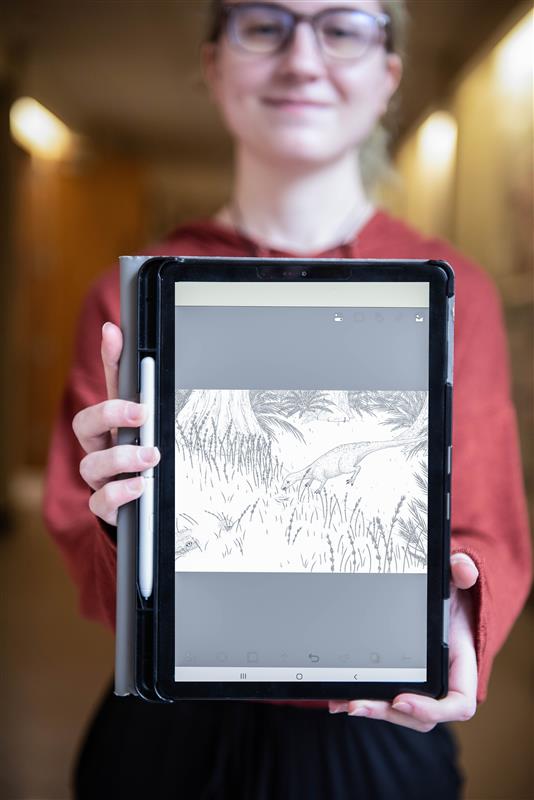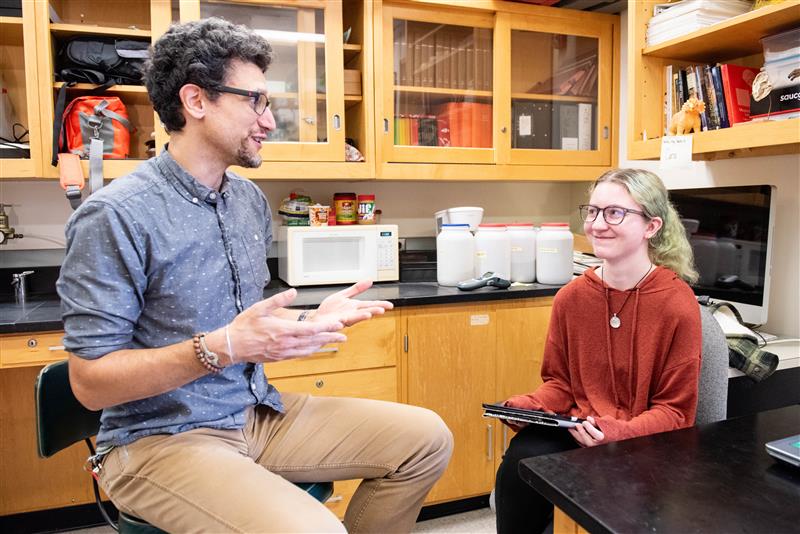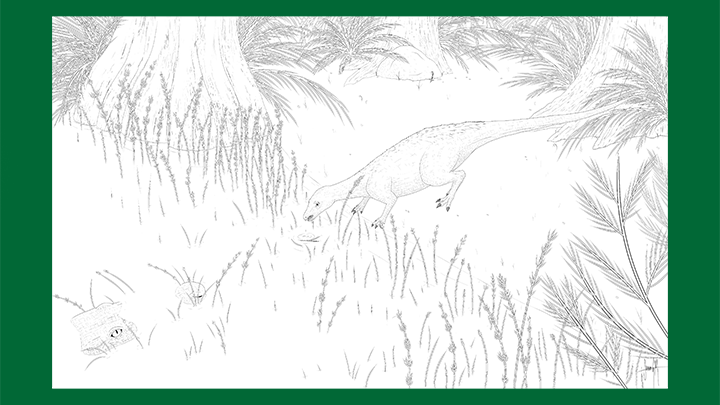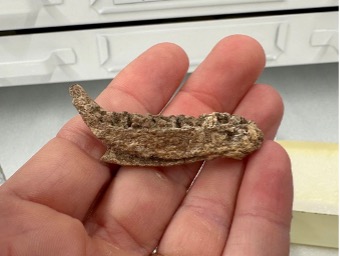UW-Parkside Student Sammi Garside-Meyers Creates Scientifically Informed Artwork for New Species
UW-Parkside’s Dr. Chris Noto Part of Team that discovered new species of small, plant-eating dinosaur: Ampelognathus coheni
 Kenosha, Wis.- For the past 12 years, UW-Parkside associate professor of biology Dr. Chris Noto and a team of other scientists have engaged in paleontological research of fossils discovered in Texas. On Friday, Oct. 13, the team published a paper announcing the discovery of a new species of small, plant-eating dinosaur which they have named Ampelognathus coheni (pronounced “AM-pell-oh-nay-thuss KOH-hen-ee”). The authors of the publication in addition to Dr. Noto are Dr. Ronald S. Tykoski (Perot Museum), and Dr. Dori L. Contreras (Perot Museum). Their work appeared in the Journal of Vertebrate Paleontology.
Kenosha, Wis.- For the past 12 years, UW-Parkside associate professor of biology Dr. Chris Noto and a team of other scientists have engaged in paleontological research of fossils discovered in Texas. On Friday, Oct. 13, the team published a paper announcing the discovery of a new species of small, plant-eating dinosaur which they have named Ampelognathus coheni (pronounced “AM-pell-oh-nay-thuss KOH-hen-ee”). The authors of the publication in addition to Dr. Noto are Dr. Ronald S. Tykoski (Perot Museum), and Dr. Dori L. Contreras (Perot Museum). Their work appeared in the Journal of Vertebrate Paleontology.
In collaboration with Dr. Noto, UW-Parkside biological sciences student Sammi Garside-Meyers has created scientifically-informed-artwork of Ampelognathus coheni for public outreach and education. She has also assisted Dr. Noto with reconstructions of other organisms that he is researching and creating learning opportunities for children in the form of coloring book pages.
Garside-Meyers is a senior from Pleasant Prairie majoring in biology. She got involved with the project after another professor who she had done an illustration for informed her that Dr. Noto could use her artistic talents as well. “When I finally got to meet him, he told me he'd like me to illustrate fossil reconstructions. I thought that sounded fun, so I started working with him and joined his lab doing both the reconstructions and some illustrations for the anatomy courses. This most recent illustration is just one of many I have done over the past several months working with Dr. Noto,” Garside-Meyers recalls.
 With the guidance of Dr. Noto, Garside-Meyers role was to draw the reconstructions. “Like each of the previous reconstructions I've done, I'm constantly reminded about how much guesswork there can be when depicting an extinct animal. You do your best with the knowledge you have but never forget you're probably getting a lot of it wrong,” she explains.
With the guidance of Dr. Noto, Garside-Meyers role was to draw the reconstructions. “Like each of the previous reconstructions I've done, I'm constantly reminded about how much guesswork there can be when depicting an extinct animal. You do your best with the knowledge you have but never forget you're probably getting a lot of it wrong,” she explains.
Dr. Noto contends that scientifically-informed-artwork is very important due to the rarity of complete skeletons and the ambiguity that can create. Dr. Noto explains, “What a lot of people don't realize is that most extinct species are based on very fragmentary material—complete skeletons are very rare. Therefore, it can be hard to visualize what the animal looked like, especially when you have so little of it. Scientifically-informed-artwork enables people to imagine what that organisms looked like and how it fit into its environment.”
 “I have worked with Sammi over the past year to create a series of artistic reconstructions of Woodbine fossils that portray them as the living, breathing things they once were. I certainly do not have the talent or time to complete such a task and I am fortunate Sammi reached out to me about opportunities in my research lab. She has been instrumental in bringing these ancient creatures back to life,” Dr. Noto went on to say.
“I have worked with Sammi over the past year to create a series of artistic reconstructions of Woodbine fossils that portray them as the living, breathing things they once were. I certainly do not have the talent or time to complete such a task and I am fortunate Sammi reached out to me about opportunities in my research lab. She has been instrumental in bringing these ancient creatures back to life,” Dr. Noto went on to say.
Dr. Noto is an associate professor of biology in UW-Parkside’s biological Sciences department. His areas of expertise are paleontology, paleobiology, fossils, dinosaurs, and evolution. Dr. Noto has collaborated with the Perot Museum of Nature and Science in Dallas for 10 years and together they have explored various interesting fossil localities around the Dallas-Fort Worth metroplex.
 At one of the locations near the spillway for Lake Grapevine, a museum volunteer found a small and unusual fossil that attracted the interest of Dr. Noto and his team. Further study by his colleagues determined this specimen to be a new species of dinosaur. His experience and expertise in the fossils of the area was essential to place the specimen into its proper context with what is known of the ancient community that existed there at that time.
At one of the locations near the spillway for Lake Grapevine, a museum volunteer found a small and unusual fossil that attracted the interest of Dr. Noto and his team. Further study by his colleagues determined this specimen to be a new species of dinosaur. His experience and expertise in the fossils of the area was essential to place the specimen into its proper context with what is known of the ancient community that existed there at that time.
Ampelognathus coheni is the first small-bodied ornithopod dinosaur discovered from the Lewisville Formation (Middle Cenomanian) of Texas. It is based on a partial lower jawbone discovered near Grapevine Lake, in Grapevine, Texas. The name ‘Ampelognathus’ means “Grapevine jaw”, and the species name ‘coheni’ is in honor of the local fossil enthusiast who found the specimen, Mr. Murray Cohen. This dinosaur lived during the Cretaceous Period 96 million years ago along the shore of a shallow seaway that divided North America into east and west landmasses at the time.
According to Dr. Noto, the significance of this discovery is that it provides a previously missing but predicted element of that ancient ecosystem. “Naming a new species is always exciting, because it means we're adding new information to science. Ampelognathus is important because it represents the first small-bodied plant-eater to be identified from the Woodbine Group. Up until this point we had very few herbivores and only one of them was a dinosaur, so it presented something of a mystery. This fossil helps fill in that gap and furthers our understanding of how the terrestrial ecosystem in the Woodbine was structured over 95 million years ago,” Dr. Noto explains.